最新译林版六年级下册英语教案 Project 2(2)
六年级下册英语教案-Project 2 A travel book 第一课时 译林版
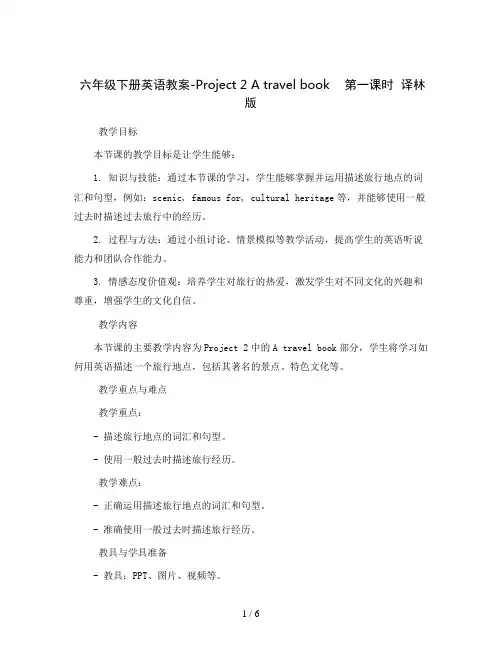
六年级下册英语教案-Project 2 A travel book 第一课时译林版教学目标本节课的教学目标是让学生能够:1. 知识与技能:通过本节课的学习,学生能够掌握并运用描述旅行地点的词汇和句型,例如:scenic, famous for, cultural heritage等,并能够使用一般过去时描述过去旅行中的经历。
2. 过程与方法:通过小组讨论、情景模拟等教学活动,提高学生的英语听说能力和团队合作能力。
3. 情感态度价值观:培养学生对旅行的热爱,激发学生对不同文化的兴趣和尊重,增强学生的文化自信。
教学内容本节课的主要教学内容为Project 2中的A travel book部分,学生将学习如何用英语描述一个旅行地点,包括其著名的景点、特色文化等。
教学重点与难点教学重点:- 描述旅行地点的词汇和句型。
- 使用一般过去时描述旅行经历。
教学难点:- 正确运用描述旅行地点的词汇和句型。
- 准确使用一般过去时描述旅行经历。
教具与学具准备- 教具:PPT、图片、视频等。
- 学具:笔记本、笔等。
教学过程1. 导入:通过展示一些著名旅行地点的图片,引起学生的兴趣,引导学生谈论自己去过的地方。
2. 新授:介绍本节课的主要教学内容,教授描述旅行地点的词汇和句型,并通过实例让学生理解如何使用。
3. 实践:学生分组讨论,选择一个旅行地点,用所学词汇和句型进行描述,然后进行分享。
4. 巩固:通过一些练习题,巩固学生对所学知识的理解和运用。
5. 总结:对本节课所学内容进行总结,强调重点和难点。
板书设计板书设计应简洁明了,突出本节课的重点和难点。
可以使用图表、关键词等形式,帮助学生更好地理解和记忆。
作业设计作业设计应围绕本节课所学内容,包括描述旅行地点的词汇和句型,以及使用一般过去时描述旅行经历。
可以让学生写一篇关于自己旅行的短文,或者选择一个旅行地点进行描述。
课后反思课后反思是教师对课堂教学效果和学生学习情况进行总结和反思的过程。
六年级英语下册Project2Atravelbook教案1新版牛津译林版
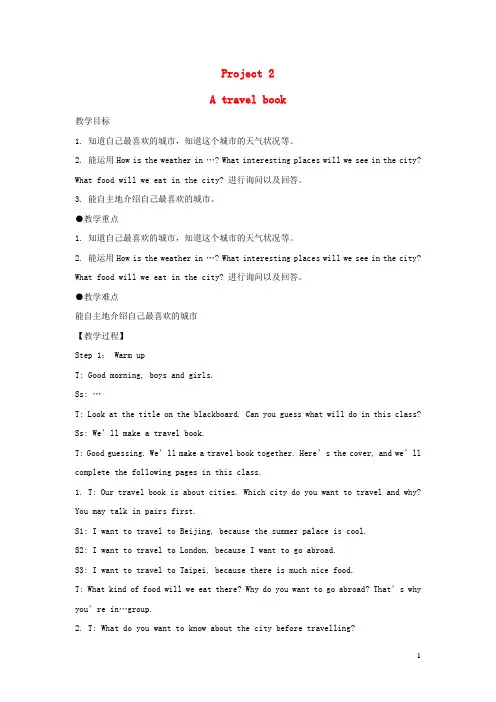
Project 2A travel book教学目标1. 知道自己最喜欢的城市,知道这个城市的天气状况等。
2. 能运用How is the weather in …? What interesting places will we see in the city? What food will we eat in the city? 进行询问以及回答。
3. 能自主地介绍自己最喜欢的城市。
●教学重点1. 知道自己最喜欢的城市,知道这个城市的天气状况等。
2. 能运用How is the wea ther in …? What interesting places will we see in the city? What food will we eat in the city? 进行询问以及回答。
●教学难点能自主地介绍自己最喜欢的城市【教学过程】Step 1: Warm upT: Good morning, boys and girls.Ss: …T: Look at the title on the blackboard. Can you guess what will do in this class? Ss: We’ll make a travel book.T: Good guessing. We’ll make a travel book together. Here’s the cover, and we’ll complete the following pages in this class.1. T: Our travel book is about cities. Which city do you want to travel and why? You may talk in pairs first.S1: I want to travel to Beijing, because the summer palace is cool.S2: I want to travel to London, because I want to go abroad.S3: I want to travel to Taipei, because there is much nice food.T: What kind of food will we eat there? Why do you want to go abroad? That’s why you’re in…group.2. T: What do you want to know about the city before travelling?S4: I want to know the weather/ interesting places/ nice food/ cost/… 教师在黑板上贴磁卡 (To summarize these aspects, we call them “others”.)3. T: How did you learn about the city (to the information)? Did you read books about it?S5: Yes, I did. /No, I read on the Internet. (注意读音)T: It seems that all of you are prepared for the lesson. That’s a good learning habit.Step 2: Presentation1. 猜谜呈现5个城市名称T: In this class, we’ll learn about the cities by reading, discussing, listening and watching. And making notes when we are learning is also important. Now please read and discuss in pairs. What cities will we talk about in our travel book? Students read the first 3 passages in pairs and discuss. Students依次反馈城市名称,教师依次拿出对应的poster,并在海报上写出天气类等信息关键词: London: changeable, foggy Hong Kong: belong to, tax-free Shanghai: between, sweet tooth同法介绍北京和台北 Beijing: Dry & cold, capital city Taipei: largest, hot, typhoon.2. 梳理句型,并反馈预习成果T: Now we know the weather in London is changeable. (带着学生一起说,并板书The weather in …is…) In Beijing, it is dry and cold in winter. (板书In… it is…) What sentences can we use to talk about the interesting places?Ss: In …, we’ll see… /In…, we can see…T: How about the nice food?Ss: We’ll eat…in…T: Now try to use these sentences to discuss what you know about the city. (点击课件呈现小组活动要求)3. 反馈海报信息,并了解各城市景点背景及美食T: Now, I’ve got all the posters. Listen carefully and guess which city it is. l BeijingT: In this city, you’ll see the Great Wall, Tian’anmen Square and Palace Museum. Which city is it?Ss: Beijing.T: Good. You’re familiar with Beijing. What else interesting places in Beijing? Ss: Summer Palace/Gong Mansion/Wangfujing Street/South Luogu Lane… Do you want to see the pictures?/Let’s read more about these places. 看图了解景点信息T: In Beijing, we’ll eat much nice food too! Can you find pictures for…?学生为海报上的美食找图片,学习课件上的其他美食表达l ShanghaiT: In this city, you’ll see the Bund, Oriental Pearl Tower and the Yu garden. Which city is it?Ss: Shanghai.T: Good. Do you know any other interesting places in Shanghai?Ss: Shanghai Museum, Disneyland park…T: Let’s look at the pictures about them. 看图了解景点信息T: In Shanghai, we’ll eat much nice food too! Can you find pictures for…?学生为海报上的美食找图片,学习课件上的其他美食表达l Hong KongT: In this city, you’ll see Victoria Harbor, Disneyland park and Ocean park. Which city is it?Ss: Hong Kong.T: Good. What else interesting places in Hong Kong?Ss: Avenue of stars…T: Good. Let’s read more about these places. 看图了解景点信息T: In Hong Kong, we’ll eat a lot of nice food like egg tart. Can you find the picture for it?学生为海报上的美食找图片,学习课件上的其他美食表达l London T: In this city, y ou’ll see the Tower Bridge, the Big Ben and the London. Which city is it?Ss: London.T: Good. Do you know any other interesting places in London?Ss: Buckingham Palace/British Museum/London Bridge… Let’s learn more about the places in London. 看图了解景点信息T: In London, there’s much traditional food. Can you find pictures for…?学生为海报上的美食找图片,学习课件上的其他美食表达l TaipeiT: Now you definitely know the last city.Ss: Taipei. T: What interesting places will we see in Taipei?Ss读海报内容: Taipei 101, Round mountain and the night marketActually, there’re much more interesting places in Taipei. Let’s see. 看图了解景点信息(National Palace Museum—Chiang Kei-shek Memorial Hall—Taipei101)T: In Taipei, we’ll eat much nice food too! Can you find pictures for…? 、学生为海报上的美食找图片,学习课件上的其他美食表达T: There’re so many interesting places and nice food in Taipei. That’s why I like it best and I’d like to speak for this city.Step 3:Consolidation1. 课件呈现“为最喜爱的城市代言”T: I’ll speak for Taipei, because it’s my favourite city. The weather here is sunny, but it’s hot in summer. Sometimes you may meet typhoon. So if you visit Taipei in summer, you should check the weather report. There’re many interesting places in Taipei, like Taipei 101. It’s the landmark of Taipei. And the New Year light show is very amazing. If you visit Taipei in winter holiday, you can’t miss it. You’ll see National Palace Museum. It’s the pride of Taiwan. History-lovers will like Chiang Kei-shek Memorial Hall. It’s built in memory of Chiang. In Taipei, you’ll eat much nice food like beef noodles, taro balls and small sausage in large sausage. If you visit Taipei, don’t forget to get the entry permit first. Come and visit Taipei. It’s a wonderful city that you’ll never forget.2. 学生完成信息卡,并装饰T: Which city do you want to speak for? Please write and share with us. If you have clear and correct words on the card, you can get one heart. If you have nice pictures on the paper, you’ll get the 2nd heart. If you have an attractive ending, you’llget the 3rd heart. Now take out your sheet and complete it. you have 3 minutes to do.3. 回到原始组,组内介绍自己最喜欢的城市T: Please go back to your original group and speak for your city in pairs. Ss talk in groups. T: Who’s ready to speak for the favourite city here? S1-S2 T: Boys and girls, time is l imited. In this class, we’ve finished our class travel book. And you’ll have your group travel book. Here are the covers. Use the binder to put all the pages together. Then speak for your favourite city in groups. This is one of your homework today. The 2nd one is to decorate your group travel book. And the last one is to complete the mind maps of the cities.【板书设计】Project 2A travel bookYour favourite city… …【教学反思】教师在单词或词组的教学中,不能只是教读单词或词组。
六年级下册英语教案-Project2 第2课时-译林版三起
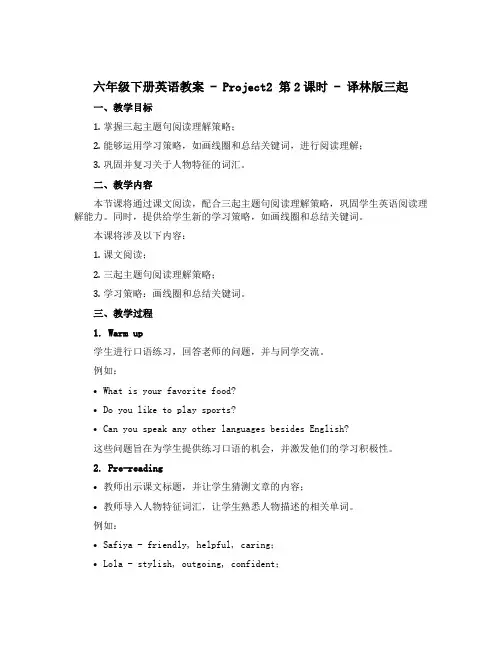
六年级下册英语教案 - Project2 第2课时 - 译林版三起一、教学目标1.掌握三起主题句阅读理解策略;2.能够运用学习策略,如画线圈和总结关键词,进行阅读理解;3.巩固并复习关于人物特征的词汇。
二、教学内容本节课将通过课文阅读,配合三起主题句阅读理解策略,巩固学生英语阅读理解能力。
同时,提供给学生新的学习策略,如画线圈和总结关键词。
本课将涉及以下内容:1.课文阅读;2.三起主题句阅读理解策略;3.学习策略:画线圈和总结关键词。
三、教学过程1. Warm up学生进行口语练习,回答老师的问题,并与同学交流。
例如:•What is your favorite food?•Do you like to play sports?•Can you speak any other languages besides English?这些问题旨在为学生提供练习口语的机会,并激发他们的学习积极性。
2. Pre-reading•教师出示课文标题,并让学生猜测文章的内容;•教师导入人物特征词汇,让学生熟悉人物描述的相关单词。
例如:•Safiya - friendly, helpful, caring;•Lola - stylish, outgoing, confident;•Jack - serious, hardworking, creative;•Oliver - shy, quiet, thoughtful。
3. While-reading教师给学生讲解三起主题句阅读理解策略,并要求学生按照这种策略阅读课文:1.第一起 - 读取开头和结尾,并思考文章的主题;2.第二起 - 找到文章中的关键词,并画线圈;3.第三起 - 总结关键词,并思考文章的主要内容。
在学生阅读完课文后,教师可以设计一些问题和练习,以便了解学生理解文章的情况。
例如:•问题1:What is the article about?•问题2:What do we know about Safiya, Lola, Jack and Oliver?•练习1:使用画线圈和总结关键词的方式,摘要文章内容。
译林英语六年级下册Project2教案讲课讲稿
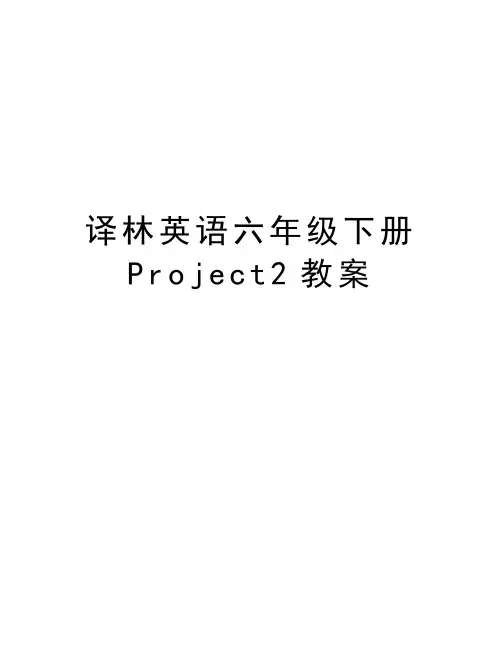
T:How about the weather/interesting places/ food?
S:...
3.T:Now please come and introduce your favourite city.
S:...
Step 4 Consolidation
1.I design
T: Please work in two and design some exercise.
a.___________ b.__________ c._______________
2.Share the design and finish the exercise by groups.
Step 5Homework
1.作文一篇My favourite city。
2.小组交流作文,请配上图片,制作成旅行日志,并在下节课展示。
A.设计一道问题。
Read and answer
____________________________?
B.设计一道判断题。
Read and judge
()_____________________________________.
C.设计一道选择题。
Read and choose
() _____________________________________.
Predicted area of difficulty
3.The students can make a class travel book of the cities and do show-and-tell.
教学准备
PPT
教学设计
Step1 Free talk
六年级下册英语教案Project2 A travel book Part B
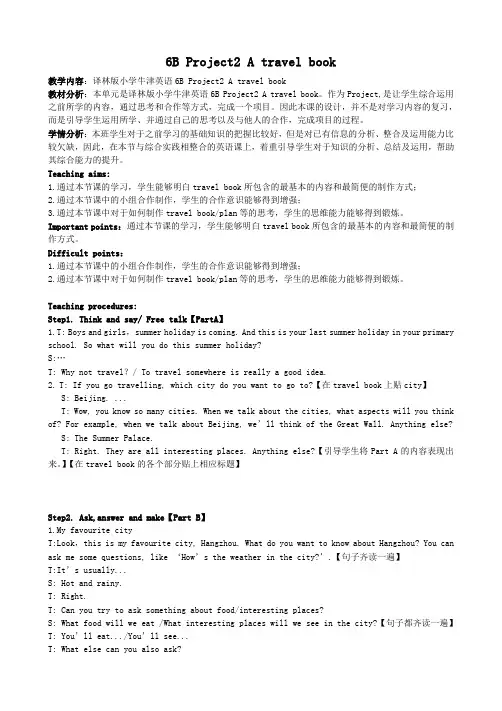
6B Project2 A travel book教学内容:译林版小学牛津英语6B Project2 A travel book教材分析:本单元是译林版小学牛津英语6B Project2 A travel book。
作为Project,是让学生综合运用之前所学的内容,通过思考和合作等方式,完成一个项目。
因此本课的设计,并不是对学习内容的复习,而是引导学生运用所学、并通过自己的思考以及与他人的合作,完成项目的过程。
学情分析:本班学生对于之前学习的基础知识的把握比较好,但是对已有信息的分析、整合及运用能力比较欠缺,因此,在本节与综合实践相整合的英语课上,着重引导学生对于知识的分析、总结及运用,帮助其综合能力的提升。
Teaching aims:1.通过本节课的学习,学生能够明白travel book所包含的最基本的内容和最简便的制作方式;2.通过本节课中的小组合作制作,学生的合作意识能够得到增强;3.通过本节课中对于如何制作travel book/plan等的思考,学生的思维能力能够得到锻炼。
Important points:通过本节课的学习,学生能够明白travel book所包含的最基本的内容和最简便的制作方式。
Difficult points:1.通过本节课中的小组合作制作,学生的合作意识能够得到增强;2.通过本节课中对于如何制作travel book/plan等的思考,学生的思维能力能够得到锻炼。
Teaching procedures:Step1. Think and say/ Free talk【PartA】1.T: Boys and girls,summer holiday is coming. And this is your last summer holiday in your primary school. So what will you do this summer holiday?S:…T: Why not travel?/ To travel somewhere is really a good idea.2.T: If you go travelling, which city do you want to go to?【在travel book上贴city】S: Beijing. ...T: Wow, you know so many cities. When we talk about the cities, what aspects will you think of? For example, when we talk about Beijing, we’ll think of the Great Wall. Anything else? S: The Summer Palace.T: Right. They are all interesting places. Anything else?【引导学生将Part A的内容表现出来。
小学英语苏教译林版六年级下册Project2_第2课时教学设计
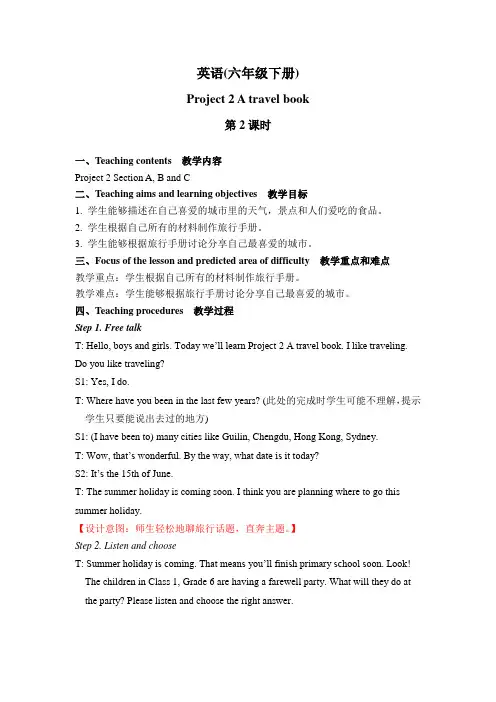
英语(六年级下册)Project 2 A travel book第2课时一、Teaching contents 教学内容Project 2 Section A, B and C二、Teaching aims and learning objectives 教学目标1. 学生能够描述在自己喜爱的城市里的天气,景点和人们爱吃的食品。
2. 学生根据自己所有的材料制作旅行手册。
3. 学生能够根据旅行手册讨论分享自己最喜爱的城市。
三、Focus of the lesson and predicted area of difficulty 教学重点和难点教学重点:学生根据自己所有的材料制作旅行手册。
教学难点:学生能够根据旅行手册讨论分享自己最喜爱的城市。
四、Teaching procedures 教学过程Step 1. Free talkT: Hello, boys and girls. Today we’ll learn Project 2 A travel book. I like traveling. Do you like traveling?S1: Yes, I do.T: Where have you been in the last few years? (此处的完成时学生可能不理解,提示学生只要能说出去过的地方)S1: (I have been to) many cities like Guilin, Chengdu, Hong Kong, Sydney.T: Wow, that’s wonderful. By the way, what date is it today?S2: It’s the 15th of June.T: The summer holiday is coming soon. I think you are planning where to go this summer holiday.【设计意图:师生轻松地聊旅行话题,直奔主题。
译林版英语六年级下册《Project2Atravelbook》单元教案
译林版英语六年级下册《Project2Atravelbook》单元教案一、教学目标1.通过本单元的学习,学生能够掌握一些和旅行有关的英语词汇。
2.学生能够了解并运用一些简单的英语表述方式,描述他们参观过的景点和其他经历。
3.学生能够培养出良好的沟通协调能力,并积极与他人合作完成一定的任务。
二、教学内容和步骤1. 教学材料1.译林版英语六年级下册。
2.PPT演示文稿。
2. 教学步骤第一步:导入导入本单元主题,让学生快速了解本单元将要学习的内容,并体会到旅游对生活的重要性。
第二步:学生自我介绍借助游戏的方式,让学生自我介绍,学习如何用简单的英语词汇和句式介绍自己和其他人。
第三步:学习旅游相关的英语词汇和表达方式通过PPT和教师的讲解,学习旅游相关的英语词汇和表达方式,帮助学生更好地理解和使用旅游英语。
第四步:合作完成旅游指南以小组为单位,让学生合作完成一份简单的旅游指南,包括景点介绍、路线推荐等内容,帮助学生锻炼沟通协调和合作能力。
第五步:学生展示自己的旅行日记让学生在小组内展示自己的旅行日记,与其他学生分享他们在旅游期间的收获和体验,并互相交流和学习。
第六步:反思与总结让学生对本次学习过程进行反思与总结,分析自己的优缺点和提出改进意见,并且探讨如何在生活中更好地运用所学的旅游英语。
三、教学重点和难点1. 教学重点1.介绍旅游相关的英语词汇和表达方式。
2.帮助学生锻炼沟通协调和合作能力。
2. 教学难点如何让学生在学习过程中更好地理解和运用所学的旅游英语,克服语言交流困难的问题。
四、教学评估1. 形成性评估1.授课结束时,通过教师的观察和小组成绩的评估,评估学生的沟通协调和合作能力是否得到了提高。
2.向学生提出一些旅游情境,让学生用英语进行交流,评估学生的口语表达能力。
2. 总结性评估1.通过课后测试的形式,评估学生是否掌握了本单元学习的英语词汇和表达方式。
2.让学生写一份自己的旅行日记,并通过评估形式来检验学生对旅行英语的应用能力。
六年级下册英语教学设计-Project 2 A travel book-译林版
六年级下册英语教学设计-Project 2 A travel book-译林版教学目标1.学生能够熟练掌握一些地理名称和旅游景点的表达方式。
2.提高学生的写作能力,学会如何撰写一本旅游指南。
3.增强学生对英语的兴趣,激发学生的学习热情。
教材分析本单元主要围绕“旅游”这一主题展开。
通过介绍不同的旅游景点,来提高学生关于“旅游”的兴趣和实际应用能力。
课本中通过查阅旅游资料和策划旅游行程等任务,让学生逐渐学会了如何策划一次自己的旅游。
针对这一主题,Project 2 A travel book 这一任务是一项十分重要的设计环节。
在完成这一任务的过程中,学生需要运用到已经掌握的英语语言表达和写作能力,并结合自己的实际情况来编写自己的旅游指南。
教学过程第一步:导入新课让学生通过图片等展示材料,带领学生来认识一下世界各地的著名旅游景点,例如塔吉克斯坦的伊斯达拉纳群山、墨西哥的玛雅各自文化遗址等。
通过展示这些图片,让类学生对旅游产生很强烈的兴趣,迫不及待的想要去旅游了。
第二步:要求学生查找资料当学生们产生了阵阵的热情后,教师便要求学生们查找各自熟知的旅游景点的相关资料。
通过查找资料的过程中,让学生了解和掌握一些地理信息和历史文化背景等,进行知识点极为深入的学习。
第三步:撰写旅游指南在学生们已经熟练掌握了相关知识后,带领学生进行旅游指南的编写。
学生们可以在自己的英语笔记本中或纸张上进行旅游指南的撰写,以熟悉的旅游景点为主题进行撰写。
第四步:学生展示当学生们完成旅游指南的撰写后,可以让学生自由展示自己的旅游指南。
在展示的过程中,学生们可以互相交流并相互学习,从中相互提高。
教学效果评估在学生完成旅游指南的撰写后,可以通过以下的方式进行评估。
1. 自评学生可以对自己的旅游指南进行自我评估,看看自己所写的内容是否充实、是否贴合实际情况等。
2. 同学评估通过展示学生所写的旅游指南,让同学们进行交流和学习。
在展示中,同学可以互相进行评估和分析,以提高自己的能力。
六年级下册英语教学设计-Project 2 A travel book 第二三课时 译林版
六年级下册英语教学设计-Project 2 A travel book 第二三课时译林版课程目标1.学生能够理解并使用如何描述风景和地点的词汇。
2.学生能够阅读英语书籍,获取关键信息。
教学重点•风景和地点的英语描述词汇。
•英语书籍的阅读技巧。
教学准备•一本优秀的旅游书籍,例如《Lonely Planet》。
•学生绘制自己的旅游地图。
•学生的学习笔记和教科书。
•连接投影仪和音箱的电脑。
教学步骤步骤1:预习在课堂上,要求学生在学习笔记中搜索并提取探索世界单元中的必要风景和地点词汇,并画出一张旅游目的地的简图。
步骤2:引导阅读旅游书在准备好的旅游书籍中,选择一部分易于理解的文章,并在学生的注视下阅读,详细讨论其中的一些重要信息和写作特点。
写作特点•文章中有大量的形容词和副词,表示对风景和地点的喜爱和赞扬。
•包括从不同的观察点描述风景的写作技巧。
重要信息•风景和地点的名称,例如海边、山区等。
•如何到达这个旅游地点。
•可以在这个地方做什么,包括吃和玩。
•旅游地点的特点和历史。
步骤3:学生自己写一本旅游书员工要求学生针对他们选定的旅游目的地,撰写一份特定的旅游书,包含一定数量的风景和地点词汇,并给出对这个旅游目的地的评论和评分。
学生的旅游书在不同的风景和地点词汇上有不同的重点,例如:•从哪里开始旅行。
•如何到达旅游目的地,包括公共交通和特别景观的提醒。
•餐厅和景点的推荐。
步骤4:展示和分享旅游书学生可以把自己的旅游书进行温故知新并向其他同学分享和展示。
让他们的同伴点赞和评分,以鼓励他们的学习。
总结这个项目是以旅游目的地为主题的阅读和写作项目,通过探寻不同风景和地点的特点并将其转化为书本和分享的过程,来加深学生对英语阅读和写作技能的掌握,并且对词汇更加的熟悉。
整个教学过程旨在激发学生的兴趣和动力,同时以体验和探索为基础,培养他们阅读和写作的兴趣并提高他们的英语水平。
译林英语六年级下册Project2教案讲课讲稿
S: How is the weather in...?
What interesting places will we see in the city?
Now, do you know what my favourite city is?
S:It’s Nanjing.
T:Yes, it’s Nanjing. It’s my hometown and I love it best.
Do you remember how I introduced Nanjing? Can you get the main aspects?
Weather
Interesting places
Know about a city Food
Mode of transportation(交通方式)
Things you should prepare(出行准备)
Do you have any more suggestions?
引导学生总结归纳从哪几个方面介绍自己喜爱的城市,多多益善。
2.The students can find information about their favourite cities .
3.The students can introduce their favourite cities to their classmates.
教学重、难点
1.The students can gain proficiency in the knowledge of Unit 6~8 in certain contexts.
- 1、下载文档前请自行甄别文档内容的完整性,平台不提供额外的编辑、内容补充、找答案等附加服务。
- 2、"仅部分预览"的文档,不可在线预览部分如存在完整性等问题,可反馈申请退款(可完整预览的文档不适用该条件!)。
- 3、如文档侵犯您的权益,请联系客服反馈,我们会尽快为您处理(人工客服工作时间:9:00-18:30)。
小学英语六年级下册课堂教案
第Project2 单元第 1 课时主备人:参备人: 教学内容Project2 A travel book
教学目标1.能熟练掌握5-8单元的重点词汇句型以及语法知识。
2.能灵活运用5-8单元的日常交际用语。
教学重、难点熟练掌握5-8单元的重点词汇句型以及语法知识。
主要教法情境法、视听法、练习法
教学准备课件
教学过程修改及调整Step 1 复习反馈
1. Read the main words from Unit5 to Unit8 correctly.
2.Read the main sentences from Unit5 to Unit8 correctly.
(回忆单词句型。
给5分钟时间背诵回忆)
3.Free talk
T: What are you going to do?
S: I’m /We are going to …
T: Are you going to …?
S: Yes, I am/we are. No, I’m not/we aren’t.
T: I’ll/We’ll ….
T: What do you think?
T: Will you…?
S: Yes, I will./No, I won’t.
T: Where/When/How long/What will you …?
S: I will/We will.[来源学_科_网Z_X_X_K]
T: What do you want to be in the future?
S: I want to (be) …
Step2 理解运用训练
图片导入
教师安排学生课前在网络上搜索有关图片,在课上和大家一起分享。
同桌合作问答,复习Unit5-8词汇、句型及交际用语。
Step 3 合作学习
1. 以不同的形式复习第五至第八单元的Story time,如:讲故事接龙、
根据提示词、表格或图片复述课文等。
2. 听写第五至第八单元的部分重要词汇。
如:Children’s Day, begin, end, clown, appear, balloon, put on, country, will, learn, welcome, visitor, like, month, find out, magazine,kangaroo, koala, sport-lover, Australian football, exciting, Sydney, for example, London, Oxford, Big Ben, London Eye, Tower Bridge
go back to, how long, photo, travel, summer holiday, stay, sound, Disneyland, Ocean Park, Taipei, traveler, travel around the world, different dream, future, tooth, take care of, scientist, artist, care about, astronaut, spaceship, football player, World Cup, dancer, pianist, come true, brave, paint
Step 4 巩固新知
Read the “Story time” from Unit5 to Unit8.
Step 5 Homework
1.Read and Act the “Story time” from Unit5 to Unit8 in roles or in groups.
2.默写第5至8单元重点词汇和句型。
[来源学科网]
教后记:
小学英语六年级下册课堂教案
第Project2 单元第 2 课时主备人:参备人: 教学内容Project2 A travel book
教学目标1.介绍自己最喜爱的城市。
2.用照片或图片制作一本旅行手册。
3.通过思考、讨论、交流和合作,介绍自己最喜欢的城市。
教学重、难点
通过思考、讨论、交流和合作,介绍自己最喜欢的城市。
主要教法情境法、视听法、练习法
教学准备课件
教学过程修改及调整Step1 Warm up.
1、利用图片,复习有关城市和国家的名词。
教师用PPT呈现中外著名城市的图片,要求学生迅速说出城市名称和
所有国家。
2、头脑风暴,复习城市的著名旅游景点。
教师出示城市图片,和学生进行回答活动,要求学生快速说出这个城
市的气候特点、特色食物和著名旅游景点或地标建筑。
[来源学科网Z.X.X.K]
3、个人活动,选择自己最喜欢的城市。
教师安排学生选择一个自己喜欢的城市,查阅资料,制作信息卡,完
成活动步骤A。
教师可以安排学生在课前完成此活动。
4、小组活动,分享交流。
教师安排学生四人一组,开展问答活动,互相介绍自己最喜欢的城市,
完成活动步骤B。
Step2 Work in pairs.
教师要求小组成员分工合作,将小组内每个学生喜欢的城市照片或图
片贴在卡纸上,然后将卡片信息写下面,并加以美化和修饰,最后做成旅
行手册,完成活动步骤C。
Step3 Do show-and-tell
1、介绍小组旅行手册。
教师安排各小组之间互相展示自己制作的旅行手册,并依照范例作介绍。
如:
S:Beijing is my f avorite city. It’s the capital of China. It’s hot in summer and cold in winter. In Beijing, you’ll see m any interesting places like the Great Wall, the Summer Palace, the Palace Museum and Tian’anmen Square. You’ll ear roast duck and many yummy snacks there.
2、评选活动
教师组织学生开展“最美旅行手册”和“城市最佳形象代言人”的评比活动,学生可以根据手册制作的质量和英语介绍两个方面进行投票。
Step4 Homework.
教师指导学生把旅行手册集中展示在教室的墙面或一角,供学生日后交流和分享。
教后记:
[来。
